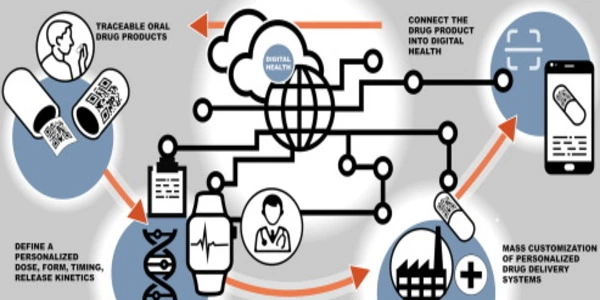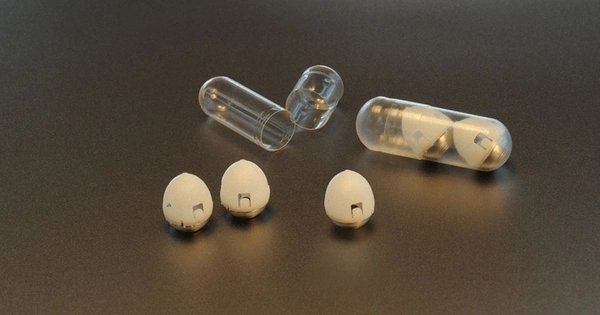Biomedicines are made by living cells and are used to treat cancer and autoimmune diseases, among other things. One issue is that the medicines are very expensive to produce, which limits global access. Chalmers researchers have now developed a material that captures and releases biomolecules using electrical signals. The new and efficient method could have a significant impact on the development of biomedicines and pave the way for the development of electronic pills and drug implants.
The new material is a polymer surface* that, when activated by an electrical pulse, switches from capturing to releasing biomolecules. This has a number of potential applications, including use as a tool for efficiently separating a medicine from the other biomolecules produced by cells during the production of biological medicines. The study’s findings were recently published in the prestigious scientific journal Angewandte Chemie.
Because of the lack of an efficient separation technique, biomedicines are very expensive to produce, and new techniques with a higher drug yield are required to reduce production costs and, ultimately, the cost of treating patients.
“Our polymer surfaces offer a new way of separating proteins by using electrical signals to control how they are bound to and released from a surface, while not affecting the structure of the protein,” says Gustav Ferrand-Drake del Castillo, who publicly defended his doctoral thesis in chemistry at Chalmers and is the lead author of the study.
The traditional separation technique, chromatography, binds biomolecules tightly to the surface and requires strong chemicals to release them, resulting in losses and a low yield. Many new medicines have proven to be extremely sensitive to strong chemicals, posing a significant manufacturing challenge for the next generation of biomedicines. The lower chemical consumption benefits the environment, and the fact that the surfaces of the new material can also be reused through several cycles is an important property. The process can be repeated hundreds of times without causing any damage to the surface.
Our polymer surfaces offer a new way of separating proteins by using electrical signals to control how they are bound to and released from a surface, while not affecting the structure of the protein.
Gustav Ferrand-Drake del Castillo
Functions in biological fluids
The material also works in biological fluids with a buffering capacity, or fluids that can counteract pH changes. This property is remarkable because it paves the way for the development of a new technique for implants and electronic “pills” that release medicine into the body via electronic activation.
“Imagine a doctor or a computer program determining the need for a new dose of medicine in a patient, and a remote-controlled signal activating the release of the drug from the implant located in the very tissue or organ where it’s needed,” says Gustav Ferrand-Drake del Castillo.
Local, activated drug release is now available in the form of materials that change state in response to changes in the surrounding chemical environment. For example, tablets made of pH-sensitive material are used when you want to control the release of a drug in the gastrointestinal tract, which has natural pH variations. However, there are no changes in pH or other chemical parameters in most of the body’s tissues.

“We believe that being able to control protein release and uptake in the body with minimal surgical intervention and without needle injections is a unique and useful property. The development of electronic implants is just one of many possible applications that could occur many years in the future. Research that connects electronics and biology at the molecular level is an important piece of the puzzle in this direction” Gustav Ferrand-Drake del Castillo says.
Another benefit of the new method is that it does not consume a lot of energy. The low power consumption is due to the fact that the polymer depth on the electrode surface is very thin, on the nanometre scale, which means that the surface reacts immediately to small electrochemical signals.
“Electronics in biological environments are frequently constrained by the size of the battery and the number of moving mechanical parts. Molecular activation reduces both the energy requirement and the need for moving parts” Gustav Ferrand-Drake del Castillo says.
The breakthrough began as a doctoral thesis
The technique was developed while Ferrand-Drake del Castillo was a doctoral student in Chalmers professor Andreas Dahlin’s research team in the Division of Applied Surface Chemistry. The project involved polymer surfaces that switch between neutral and charged states depending on the pH of the surrounding solution. The researchers were then successful in developing a material that was both strong enough to remain on the surface when subjected to repeated electrical signals and thin enough to actually change pH value as a result of the electrochemistry on the surface.
“We soon discovered that we could use electrical signals to control the binding and release of proteins and biomolecules, and that the electrode material works in biological solutions such as serum and centrifuged blood. We believe and hope that our discoveries will be very useful in the development of new medicines” Andreas Dahlin explains.
In the last year, the findings of the Chalmers researchers have been applied to product development by the spin-off company Nyctea Technologies. Customers include leading pharmaceutical researchers and companies.
[Note: Polymers are chemical compounds that consist of very long chains made up of repeated smaller units. Common plastics are a form of polymer.]











